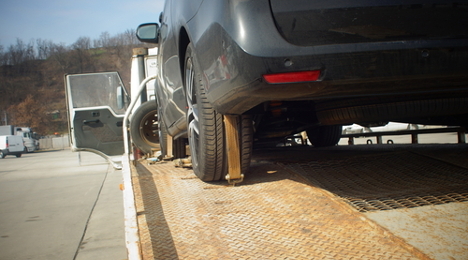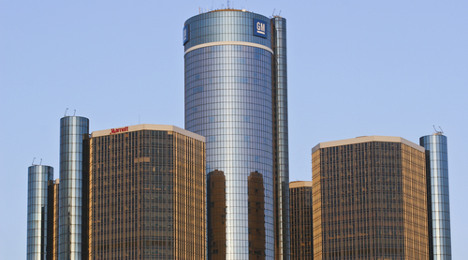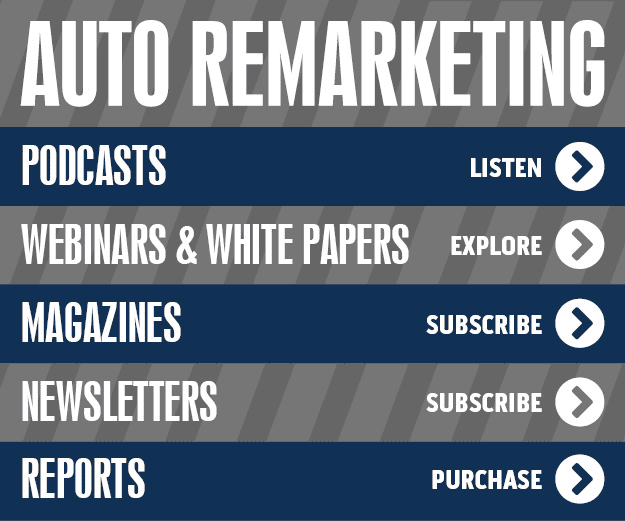Online pre-qualified monthly payment marketing technology DriveItNow finalized a partnership on Tuesday with Purple Cloud, a provider of retarget marketing for dealers.
Executives explained that Purple Cloud technology will reinforce DriveItNow’s monthly payment shopping process by driving shoppers who abandon the dealer website back to complete the buying process.
DriveItNow’s patent pending technology can display real monthly payments using dealers’ lender programs and consumers’ actual credit bureau information, without the need for Social Security numbers or birthdates and adversely affecting consumer credit.
Purple Cloud’s advanced marketing platform can tracks and targets consumers on dealer websites, offline marketing collateral and across premium website publishers using retarget marketing through a single dealer website integration.
The companies went on to mention online customers who abandon or do not start the DriveItNow monthly payment shopping process will see dynamic, content specific, retargeted ads encouraging them to come back to complete the shopping process. Clicking the ad brings the customer back into the process improving the overall experience.
“We are excited to partner with DriveItNow given their proven results of increasing sales for auto dealers,” Purple Cloud chief executive officer Josh Shatkin-Margolis said. “Combining DriveItNow's monthly payment shopping process with our feature-rich retargeting tools allows consumers to do their research and then be brought back to continue the buying process with the dealer.
“This digital marketing partnership keeps the car dealership firmly in consideration throughout the vehicle shopping process,” Shatkin-Margolis continued.
According to comScore, retargeting has the highest brand lift of all forms of digital marketing at 1,046 percent. Product-specific dynamic ads have been shown by eMarketer to be noticed by three out of five online buyers.
“We are very pleased to partner with Purple Cloud to bolster the completion rate of our monthly payment shopping process and increase auto dealers' sales,” DriveItNow president Tarry Shebesta said.
“Their vast experience and proven tools significantly increase engagement by guiding customers back to the dealer’s website to reclaim lost sales opportunities,” Shebesta went on to say.
Although there have been plenty of articles written about how to prepare vehicles for shipment and how to save transportation costs and time, not a lot has been written about the other end of the process: how to receive shipments at your dealership.
It doesn’t make sense to spend a lot of time and money arranging for transport only to encounter difficulties at the final destination.
To help ensure easy deliveries, I’d like to offer the following tips on how to prepare your dealership to receive vehicle shipments.
- Have an allocated delivery drop area
- This will help ensure a safe unload of your vehicle(s) while maintaining the safety of the driver, your staff and your customers.
- As a rule of thumb, drivers need at least 150-175 feet of clearance (that includes the length of the truck).
- Communicate with the transport company
- It’s always good to communicate any changes in delivery area or receiving hours to your dispatcher to avoid delays.
- You’ll also want to let your dispatcher know of any changes in infrastructure (e.g., different entry gates, low-clearance bridges, major road construction) in your area.
- Having a point person ensures that the right vehicles are delivered to you. There are times a driver arrives at a dealership and can’t unload because he can’t find a person who knows about the delivery.
- Inspect your vehicles
- When your vehicles arrive, make sure to do a thorough inspection with the driver present. Drivers should perform an inspection at the time of pickup and note any existing damage, if any, on the Bill of Lading. When the origin of the shipment is an auction, any damages found are noted on the vehicle gate pass. Use the BOL to note any damages on the vehicle. The driver will keep a copy of this “condition report,” as will you. Sign the BOL only after you’ve inspected the vehicle.
- If your dealership accepts deliveries after hours, the BOL will have a “Subject to Inspection” stamp or signature written on it. As soon as you are able to take physical possession of the vehicle, you should still do a thorough inspection.
- If you see damage, take pictures and contact the claims department at the transport company as soon as possible. Even if you do not have pictures, the sooner you report the damage to the claims department, the better.
- Signing a clean BOL, or not having one at all, will make it very difficult to file a claim.
- Also keep in mind that normal wear and tear on a pre-owned vehicle is not considered major damage. Defining what constitutes normal wear is perhaps a good topic for a future article.
- Check the driver’s paperwork
- When a carrier arrives at your dealership, have your point person check the BOL to make sure the driver is at the correct location, and verify the vehicles that are intended for your business. A carrier can have a full truckload but only one or two vehicles may be for your location.
- Many times a carrier is transporting two or three vehicles of the same make and model. Always verify that the VIN number on the BOL matches the VIN plate on the vehicle.
Following these steps will ensure a smooth delivery process, and you don’t have to wait until your next order to notify your dispatcher of any changes.
Martha Garcia-Perry is director, account management with MetroGistics (www.metrogistics.com).
When you’re driving down the road, how many of the cars in motion around you are being physically driven by fellow humans? More often than not, all of them.
Thinking of an answer to this question, today, may seem quite silly. By the time our millennial readers are old and gray, however, it won’t be.
It’s well known that a variety of auto manufacturers and outside technology companies are preparing for the day that autonomous driving becomes mainstream.
In fact, a small percentage (8 percent) of the 175 automotive executives in 21 countries that IBM surveyed in its Automotive 2025: Industry without borders study think autonomous vehicles will be in mainstream use as soon as in the next 10 years. A much larger percentage (38 percent) think they will at least be in limited use in the mainstream market.
“But how does that affect my dealership today?” you may ask.
Well, there are plenty of autonomous features that are currently hitting the mainstream — and consumers want them. The technologies may not be driving the cars for us yet, but with lane-departure warnings, autonomous braking, and guided cruise control, it’s safe to say we’re perhaps not that far from it.
Autotrader recently presented the findings of its 2016 In-Vehicle Technology Shopper Influence Study at the 2016 International Consumer Electronics Show (CES) and a not-so-surprising percentage of consumers would like more autonomous features in their vehicles.
After surveying a panel of over 1,000 vehicle owners online last year, Autotrader found that 70 percent of the consumers surveyed are more likely to consider a vehicle with autonomous features, such as parking assistance, collision avoidance and automatic braking.
One interesting finding, fleshed out by Autotrader’s associate research manager Rachelle Petusky, is that these in-car technologies are changing what many consumers perceive to be a luxury vehicle.
“When we ask consumers about what defines a luxury vehicle, traditionally in the past consumers have broken it out by automakers that play in the luxury space, such as Audi or BMW,” Petusky said. “But technology’s really changing the game, and non-luxury vehicles are starting to be viewed as a luxury vehicle because of the technologies offered in the car. Things like Wi-Fi, lane change assistance, collision avoidance are helping consumers perceive non-luxury cars as luxuries.”
Since this is the second year that Autotrader has conducted this study, Auto Remarketing asked Petusky what the biggest change Autotrader has seen seen in consumer expectations over the last year.
Petusky pointed to the 77 percent that want a car with all of the technology features they want regardless of car color.
“Probably the biggest change that we saw was the fact that technology is becoming even more important than car color,” Petusky said. “Car color, I think, has been a part of a huge conversation. It still is very relevant in the purchase decision, but technology is definitely going to have more of an impact now than it did last year.”
While Autotrader finds that the majority (60 percent) of the consumers surveyed think self-driving vehicles are a dangerous idea, there are plenty that are more than willing to pay extra for the new technologies that are out today.
Forty four percent of those surveyed said they would pay up to $1,499, which Petusky says is a bit of a “magic number” in the technology package pricing game, for an in-vehicle concierge service. And 65 percent said they would switch brands to get the features they want.
On that note of branding, while Petusky says that in the immediate term it isn’t that cost effective to upgrade used vehicles with some of the new features that are coming out, the used cars that are most popular in the future will be heavily dependent on who adapts what technologies in their new vehicles now.
“But I think as automakers and technology companies figure out how to make it more cost-effective, it is going to start shifting consideration,” she said. “We’re already seeing some consumers that are shopping for new cars that are going to switch brands if the technology that they want isn’t in the car that they want.
“So I think even as people are looking at used cars, it may change which used car they’re considering depending upon which manufacturer is earlier to the game to introducing new technologies in their cars.”
These new technologies are also expected to not only change how automakers certify used vehicles in the future, but also impact the value that used cars retain.
“I think there’s definitely certain things that they’re going to have to check to make sure they’re functioning properly,” Petusky said. “Our sister company, Kelley Blue Book, is actually seeing that vehicle technology is impacting the valuation price of used inventory.
“I think that vehicles that are in good or excellent condition that have that additional technology in the car, it’s just going to be a way that they can ask for a higher price point and that inventory is going to move faster compared to certified inventory that doesn’t.”
Petusky also thinks that dealers and aftermarket companies that can add some of the more affordable new technologies, especially backup cameras, to older vehicles, can reap the benefits.
“That’ll really be a way to differentiate themselves from other dealers,” she said.
There is one feature that customers don’t necessarily care for their vehicle to have completely integrated: navigation. Fifty seven percent said they would rather manufacturers focus on better integration with their smartphones, while 39 percent said they would prefer the navigation system on a smartphone rather than one built into the vehicle.
“We definitely see it continuing to swing toward people wanting to just use the navigation system that’s in their phone,” Petusky said. “But they are wanting that to easily integrate into the dash. Some of the other apps and functions that people are doing on their smart phones now they are willing to surrender to the dash.”
With more than 235 model options in the new-vehicle marketplace, customers shopping in that arena are a bit spoiled for choice. Understanding what customers are drawn to, and, perhaps more importantly, turned off by, can be what sets a good car apart from a great car.
That’s where the annual J.D. Power Avoider Study comes in, and this year its analysis has shown an increased concern for vehicle reliability.
According to the study, which surveyed nearly 26,500 owners who registered a new vehicle in April and May of last year, 55 percent said that vehicle reliability was a leading reason for their purchase, up from 51 percent in the previous year’s study.
Looking at it from the opposite angle, 17 percent said perceived reliability was a chief reason why they avoided a certain vehicle, versus 14 percent the previous year.
"Though vehicle reliability and durability have improved significantly over the years, they remain a vital consideration for consumers," said Dave Sargent, vice president, quality practice, J.D. Power. "With so many auto recalls in the news and challenges with the introduction of new technology, consumers are even more attuned to the expected reliability of new vehicles.
“This impacts which models consumers avoid and which ones they ultimately purchase,” he continued. “Bad news can tarnish an automaker's reputation in an instant, yet, can take years to build back up. Automakers need to convince consumers of the true reliability of their vehicles so it is not a reason to avoid selecting a particular model."
Above reliability, exterior and interior styling still remain the top two most frequently cited reasons for buying a vehicle.
Lower gas prices also appear to have made an impact on consumer preferences, as J.D. Power points out that 51 percent of shoppers factored in fuel economy when purchasing their vehicle in 2015, down from 55 percent in the previous year.
Although nothing new, another issue that has stuck around is the fact that some shoppers tend to change brands because they simply want to try something new.
"This is a major challenge for auto marketers," Sargent said. "In the auto industry, building consumer trust, loyalty and advocacy is paramount to ongoing success. However, there are so many great vehicles available to consumers that merely satisfying your customers is simply the cost of entry.
“To truly succeed, automakers must keep their exterior and interior designs fresh, ensure competitive performance and fuel economy levels, offer an array of advanced technology and achieve an excellent reputation for vehicle reliability."
Here are a couple more key findings from the report, as listed by J.D. Power:
- Car Buyers Doing Less Window Shopping: Since 2012, new-vehicle buyers are considering fewer models and shopping fewer dealers. On average, buyers physically shop only three models, one of which they buy.
- Domestic Brands vs. European and Asian Brands: There remains a significant disconnect between perception and reality regarding the reliability of domestic brands compared with European and Asian brands. Avoidance of domestic models due to reliability concerns (24 percent) is nearly twice that of European (13 percent) and Asian (12 percent) models. In reality, the actual reliability of most domestic models is competitive with that of their import competitors.
The supply of certified pre-owned inventory for General Motors dealers is not going to be impacted by the automaker’s Factory Pre-Owned Collection program, the manager of that program told Auto Remarketing on Wednesday afternoon.
“A lot of those (CPO units) come from trade-ins, so they still have that channel,” GM’s Tom Kinney said. “And then, this process actually is working in parallel with our current remarketing auction process, so all of these vehicles that we’re listing, the dealers will still have access to via the wholesale auction. So, it will not impact their supply of vehicles at all.”
It was announced Wednesday that with a new online program set to launch next month called the Factory Pre-Owned Collection, General Motors through its dealers will sell low-mileage GM lease, daily rental and company-owned vehicles.
(It should be noted that consumers are actually buying the vehicles from the dealerships themselves, and not directly from the OEM. GM explained that its dealers buy the cars wholesale from GM or GM Financial, and then the retail customer buys the car from the dealer, who sets the final price.)
The Factory Pre-Owned Collection will include low-mileage GM lease, daily rental and company-owned vehicles.
But one thing it will not include is CPO.
Think of used cars in three buckets, Kinney said: the “normal” used cars you might find on a dealer lot, the Factory Pre-Owned Collection vehicles listed in this portal and CPO.
“The way I look at this, it’s just another avenue that consumers and dealers have to access used vehicles,” Kinney said. “So, the certified piece of it will still be wholly through the dealership.”
He sees the Factory Pre-Owned Collection as having trickle-down benefits for CPO, as well, primarily in the areas of “exposure and awareness.”
With the program working “hand-in-hand” with GM’s CPO department, the more marketing push and traffic GM can get to its inventory, the better, he said. The two can work together in building awareness.
“I think that someone might look at one of these and contact a dealer, and the dealer might have a similar one that’s certified on their lot that they could sell,” Kinney said.
Kinney also explained the reconditioning process for these vehicles.
The vehicles undergo a screening process by the automaker. GM assesses the damages and conditions of the vehicle once it has been turned in from the company vehicle operations, rental company or off-lease from the consumer, he said.
GM photographs the vehicle and uploads those photos to the site. After a consumer selects a car and sets up the purchase at a store, the reconditioning is done at the dealership.
As for transport from the grounding location to the participating dealer, the dealer makes arrangement, same as they would for buying a car at an auction.
With the program being an extension of the Shop-Click-Drive program, Kinney explained how financing fits into the process, as well.
“The process, essentially, is the consumer picks a vehicle, then selects a dealer. And once they select a dealer, it actually goes into the existing Shop-Click Drive process. Part of that process gives them the option to fill out a credit application, which then the dealer will take and work with their financial institutions to provide the approval,” he said.
Businesses today, large and small, are facing what seems to be the most impatient generation of humans ever when it comes to commodity acquisition. They know what they want and they want it now. And that impetus also extends to their vehicle purchase transaction — which they want to be quick and painless.
This is not “new” news, so to speak — companies like AutoNation and General Motors, among many, are trying a variety of new processes to make it simpler and easier for customers. They understand that if it’s easier for the customer, it’s easier for the dealership. Quicker sales equal quicker profit possibilities.
That sense was reiterated by dealers surveyed by eLEND Solutions, who released the results of a study today that it conducted online among U.S. dealerships in November.
Their findings show that those surveyed, despite wanting things to move quicker, are still saying that the sales process is taking, on average, three hours or more to complete.
Here’s a breakdown of eLEND’s survey:
- 85 percent of dealers think it would be ideal to bring the car-buying process down to two hours or less (up from 59 percent in 2014).
- Since eLEND’s similar survey in 2014, dealers, overall, are not showing much of a change in the speed of the sales process. In 2015, 42 percent said the average sale, from start to finish, lasts 3 to 5 hours. Forty percent said the same in 2014.
One key issue that many dealers — 86 percent — fleshed out in the survey is their issues with vendor integration. This majority of dealers agreed that they experience a significant obstacle in the lack of integration and data exchange between their vendors’ systems, hampering the connection between their online tools and their in-store processes.
This 86 percent agreed that improved cooperation and data sharing could eliminate online to in-store information disconnects and bottlenecks.
“The survey confirms that the sales process can’t evolve — or speed up — unless vendors start connecting the online and offline dots, yet the lack of systems integration means that dealers are unable to embrace new processes,” said Pete MacInnis, chief executive officer of eLEND Solutions. “The way to shorten the customer sales journey — and sell more cars in the process — is to create seamless, real-time integrations between the dealer website, CRM, Desking/Finance and DMS platforms.”
Unfortunately, many of the dealers surveyed are not very optimistic in the idea that this may actually be addressed. 54 percent of the dealers said that it is only somewhat likely and 19 percent said it was unlikely that this type of cross-platform integration may actually come to fruition.
Here are a few more highlights from the survey, listed below by eLEND Solutions:
- Of those that think open integration is unlikely, competition and protecting the status quo were cited as the top reasons.
- 86 percent of dealers strongly agreed or agreed that vendor cooperation and coordination could facilitate a greatly reduced start-to-finish transaction time.
- Nearly 60 percent of dealers agree that specialized best of breed solutions are the way to go because of their higher product quality and service levels (70 percent).
Many companies, including dealerships, tend to tout company culture as part of their recipe for success.
Not very many, however, tend to survive three generations of familial torch bearing and reap the rewards quite in the same way as Ohio’s Ricart Automotive Group.
It started with Paul Ricart on Independence Day in 1953 as a single-point Ford franchise in Canal Winchester, Ohio — with four cars and one garage.
And these days? In late 2015, the dealer group was expecting to have retailed roughly 8,500 used vehicles out of its Ricart Used Car Factory by the end of the year.
As part of this year’s “Leading Dealer Groups” issue, Auto Remarketing spent some time talking with Rick Ricart, third-generation member of the group as well as its current vice president of sales and marketing, to see if he could share some sales tips.
Cutting straight to the issue, we asked Ricart what his group’s overall sales strategy is, distilled down into one statement.
“We are very, very consistent with everything we do. We have consistent training. We have a consistent culture,” Ricart said. “But we are dynamic when it comes to each individual customer as we engage them because there are so many types of buyer today depending on how much research they’ve done and everything.
“I would say our strategy is, ‘sustainable growth through consistent processes, by treating each individual customer based on their needs and demands.’”
Well, that seems to make sense — consistent culture, dynamic approach to customer service — but how is that achieved? To start off, Ricart says one key to obtaining quality sales men and women for his new and used stores is to, well, not hire people who have done it before.
“Four years ago now, I adopted a policy where we don’t hire car salesmen,” he said.
How does that work? For starters, Ricart says they don’t hire the “transient” car salesmen that tend to bounce around from dealership to dealership, spending six months or so at one business before moving on to the next — an issue that he says has plagued the Columbus area in the past.
“What we decided was we were sick of hiring people that had been taught bad habits, that had been taught to lie, cheat and steal,” Ricart said. “What we really need are people that are focused on customer service and that don’t have the entitlement of a lot of millennials that refuse to work 40 hours a week, or work weekends, or work nights. So four years ago we took a strategic move and started hiring from the service industry.”
That’s right — former servers, bartenders, hotel front-desk staff, valets — that’s the Ricart sales staff’s bread and butter.
“We found people that have the personality, the customer service training, the character — and brought them into the car business,” he said.
To Ricart, today’s business isn’t about learning how to be a salesman. It’s about letting the customer, who, more often than not, has come into the store following an incredible amount of research, take the reins and have the sales staff simply help them find what they’re looking for.
In fact, that’s exactly how Ricart’s management phrases it to their sales staff. Of Ricart’s 550 employees across its new and used stores, 62 are sales people in the Ricart Used Car Factory. And they’re not allowed to sell anything.
“That’s what we tell them all the time, ‘you’re not to sell a car today. But you’re to let two or three people buy a car that you meet,’” Ricart said.
‘Family owned and people driven’
That “internal tagline” is what Ricart attributes to his company’s cohesive culture — the reasoning behind its ability to retain many of its employees long term and give them a feeling of openness and honesty.
“We are very employee-centric. We don’t shun them for sharing ideas, criticism,” he said. “We let our employees take ownership in their job and the dealership itself. And we have a lot of long-term employees that help reiterate all of those culture-based programs that we do. And we actually have an in-store employee engagement director.”
In an environment where employees take ownership of their positions and care for the overall well-being of the business, Ricart says this helps make his job easier.
“It allows me to do my job better because I’m not worried about what I say, because everything is very honest and transparent and open with everyone,” he said. “Management truly defends the employees, as well.”
Another tip that Ricart gave for dealers is that if you want to build a fan base for your dealership, you have to start with your own employees.
“We learned years ago when we started our culture change that if the employees aren’t advocates of the dealership the customers never will be,” he said “That sounds crazy, but I remember five years ago there’d be someone that worked in the service department that didn’t want to buy a car from the company they worked for because they didn’t get along well with the used-car department.
“It gave us a lot of opportunity to improve those things. You need to make sure that every employee is proud of where they work.”
Success of the used-car recon department
Speaking with Auto Remarketing in late December, Ricart said the turn-time that week in the Ricart Used Car Factory’s reconditioning department was currently 5.2 days, with its peak at one point as low as 3.9 days. The recon team, which utilizes the Motor Trend Certified Vehicle program, tries to get each vehicle show-ready in less than four days so it can go into the “photo lab,” where each vehicle gains 27 high-quality photos and is put online for sale.
Ricart says he enjoys the program because, instead of having six different teams, one for each make, he has one team certifying all of the Factory’s vehicles. That one team, with 20 technicians designated to used vehicles, shares 14 service bays and performs the same inspection on each vehicle. He says the recon department has come a long way — when they first started tracking turn time on vehicles, they stood at 11 days.
The goal of “sustainable growth” is exactly what is reflected in his Used Car Factory’s sales figures. At the end of November, it had sold exactly 7,787 used vehicles in 2015, an over 700-vehicle increase over the first 11 months in 2014 (7,054 used-units retailed) and roughly tying the overall sales figure for 2014. Speaking conservatively, Ricart says the Factory was expected to end the year at 8,400 to 8,500 used units retailed, a 10-percent jump over last year’s figures.
Ricart says he knows the Factory could retail quite a bit more — but the focus is currently on quality over quantity.
“We’re looking for sustainable growth,” he said. “We could go buy a whole bunch of cars as cheap as we can and lose money to market them and say, ‘Hey, we sold 10,000 cars this year.’ But if you don’t sell 10,000 or more next year, then it was false pride, or whatever you call that.”
Everyone who has been in the car sales business since the dawn of the Internet age will probably agree that, well, things are a lot different than they used to be.
Customers are more informed. There are a lot more ways to sell a vehicle. But as the old adage goes, as things change, many stay the same.
That was one important message shared by Rick Ricart, the vice president of sales and marketing at the Ricart Automotive Group and third-generation car salesman.
When recently speaking with Ricart, Auto Remarketing asked him how he has seen the business change over the course of his lifetime, more than three decades of which which he has spent in the car industry.
“Since I’ve been in business, it’s a lot less forgiving … I think of the old adage of, ‘a used car bought right was already 50 percent sold.’ And today, if the right used car is bought right and merchandized correctly, it’s 85 percent sold,” he said. “The other 15 percent is just not making the customer want to leave.”
And, for the most part, many salesman can probably agree. By the time they reach the dealership, the average customer is much more informed about their purchase than they were prior to the digital information age. More often than not, a customer knows more about a specific vehicle than the average salesman who has to know about a wide variety of vehicles. Which is what lead to Ricart’s policy of not allowing sales staff to “sell cars,” but instead “allow customers to buy a car.”
Referencing the sales strategies of companies like Carvana and Vroom, Ricart thinks that although these types of niche businesses have the potential to steal some business from traditional dealerships, they also give dealerships an opportunity to adapt to the new ways customers want to buy cars.
“I think as people get more comfortable and the word of mouth spreads that there are alternative ways to buy a car, we’re going to see a bit of an impact. I mean, eBay came on the scene, and I think by 2007, they were the No. 1 used-car seller in the world,” he said. “Well, okay, they’re No. 1 in the world, but they haven’t affected us at all. So there’s such a big market for selling used cars, I think it’s OK to have some of these niche and segmented ways of buying.
“I think from a dealership perspective, we just have to adapt to be able to fit all of those different buyers’ bolts. And if you’ve got a certain buyer in your market that wants to buy a car online, a la Amazon style, you need to be able to cater to that customer,” he said.
“Be able to provide all of that information electronically. Be able to communicate, negotiate, short of doing the actual transaction. Do it all online. Be open and honest. And understand the more open, the more honest, the more accurate we are with that consumer, the greater the chance they’re going to come in and finalize the business with you,” Ricart added.
To learn more about Rick Ricart and his family’s three generations of business that built today’s Ricart Automotive Group, be sure to check out Auto Remarketing’s upcoming “Leading Dealer Groups” issue, coming out in print and online this month.
At the close of the third quarter, our nation’s seven publicly traded dealer groups collectively averaged their 25th consecutive quarter of same-store used unit sales increases.
Cox Automotive’s chief economist Tom Webb, speaking during the Manheim Index Quarterly Conference Call on Friday, says a 26th is probable, but will be a challenge to achieve.
“Slide 14 shows the seven publicly trade dealership groups and it shows that they have had 25 consecutive quarters of same-store growth in used-units retailed,” Webb said, referring to slides accompanying his presentation. “Achieving the 26th quarter will be a little bit difficult because CarMax has already reported a 0.8-percent decline in their quarter, which ends in November.
“But I still think the 26th quarter will be achieved because CarMax was more focused on supporting gross than I believe that the others will be. Which, obviously, writes in the equation, that by extension, I expect the downward sloping lines in Slide 15 will also continue.”
And the latter slide, as you probably inferred, references the used-vehicle retail gross margin for the same publicly traded dealer groups. The gross margins for used sales for the public groups is currently trending to its lowest percentage in several years — a trend Webb says has two faces.
“Now, there are two ways of looking at that gross margin trend. One could just say it’s plain ugly, and it’s dangerous,” he said. “Or, you can argue that it’s just simply the case of a competitive industry passing on its efficiency savings to the consumer. Obviously the truth lies somewhere between the two.
“But more importantly, from my perspective, I do not believe that grosses should, and hopefully they won’t, go much lower. So that means don’t look for operating efficiencies at the retail level to continue to bail out the commercial consignors. The dealers have done more than their part,” Webb said.
He says dealership proficiencies have helped that margin decline due to the lowered costs of operation that result from such efficiencies.
“A lot of that reduction in gross, I wouldn’t say was ‘willingly’ given away, but because there were tremendous increases in operation efficiencies, other dealers were able to give it away,” Webb said. “The ability to keep achieving those operating efficiencies I think are a little bit limited going forward. And certainly the benefit of exceptional growth in the throughput has probably slowed it a little bit, too.”
For more takes on Webb’s analysis, including the used-car market’s current stretch of wholesale price stability, click here.
CarMax noted a slowdown in its stores’ foot traffic during its fiscal third quarter, resulting in a decrease in same-store used-vehicle sales.
However, the retailer still tallied an increase in overall used-car sales with its new rooftops added in the last year.
In fact, the company sold over 154,000 used units overall last quarter, resulting in its best-ever Q3 used unit sales total.
That averaged out to roughly 340 cars sold per month for each store.
Getting into specifics, CarMax president and chief executive officer Tom Folliard pointed out during the company’s mid-December conference call that although used unit sales in comparable stores fell by 0.8 percent in the third quarter, total used units increased by 3.2 percent.
“As you saw, we had a challenging third quarter, due primarily to slightly negative used-unit comps,” Folliard said.
“Our lower used-unit comps were primarily a result of modestly lower traffic in our stores, partially offset by better conversion,” he continued.
CarMax attributed the slowdown in traffic to the following:
- A decrease in supply of 5- to 10-year-old vehicles
- Very aggressive promotions and lease offerings on new vehicles that appear to pressure sales of zero- to 1-year-old cars
- An increase in the wholesale prices of SUVs and trucks, so some don’t represent a “good value” for its customers
- A shift to fewer lower-credit customers and more prime-credit customers
Eighty-four percent of CarMax’s sales were zero- to 4-year-old vehicles in Q3, compared to 74 percent a year ago. SUVs and trucks made up 23 percent last quarter, down from 25 percent by the same metric a year ago.
During the company’s conference call, one analyst asked if the lower number of SUVs and trucks sold was due to a higher number of leases, resulting in fewer of the vehicles making it back to auction and thus becoming available to CarMax. Folliard noted that too many leases couldn’t hurt CarMax’s options at the auction because there are far too many for dealers to take on.
“Well, it’s something we’ve lived through before, in terms of percent of new-car sales that are leased. I think the number now is around 30 percent,” Folliard said. “It’s been this high, at times, before. Generally, what that means is that two or three years down the road, those cars will come back to the market in kind of a more organized way, and dealers won’t be able to absorb the volume that comes back and a lot of those cars end up at auction.
“That’s what’s happened historically, and we’ve been able to take advantage of that in the past. I never look at a high-lease environment as a negative for us when you think of supply two or three years later,” he continued. “If you think about the cycle of people getting out of a new car, if it remains that people get out of that car every three to five years, it really doesn’t make any difference whether it comes back through a lease channel or it comes back as an individual car, eventually they end up in the open marketplace, and we have an opportunity to buy them.”
CarMax did point out that good examples of trucks and SUVs, at favorable prices, were hard to come by in Q3, due to their high values at auction. Folliard doesn’t believe it will be that way forever.
“Prices were pretty high during the quarter. As you know, we buy a lot of cars at the auction and our buyers are trying to make sure we always deliver a great value to our customers,” he said. “There were times during the quarter where we just didn’t think it was worth overpaying at the expense of giving a great value to the consumer.
“You know, I think this is probably short lived. Obviously it’s been driven by low gas prices. We’ve seen bigger increases in new-car sales as it relates to SUVs and trucks compared to the used-car market increases. But, you know, ultimately all of these cars will come back into the market at some point.”
Plenty of stores on tap
CarMax opened two stores in existing markets in the third quarter, including its sixth store in Houston and its second store in Minneapolis. The company also relocated one store to the Washington D.C. and Baltimore market, with two more joining the Boston market shortly after the close of Q3.
In addition to those two Bostonian stores opened in December, CarMax plans to open three more stores in its fourth fiscal quarter (which ends Feb. 29) and an additional 11 stores in the next fiscal year.
To check out CarMax’s full Q3 results, click here.












